guide
Process
architecture
The Pre-Development Phase - What is Software Architecture?
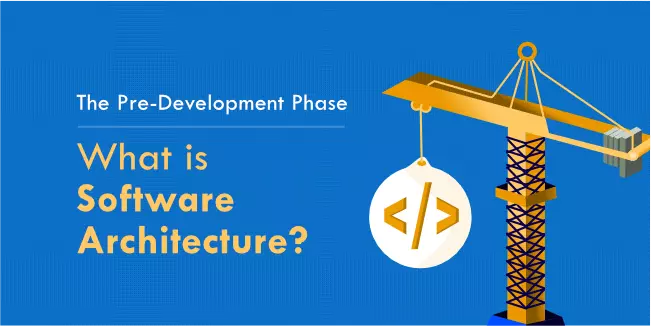
The first steps are the most important because the foundations are responsible for the proper functioning of the rest. It is a well-known proverb, and there is a lot of truth in it, but it is worth remembering that the foundations are not at the very beginning. Before the foundations are laid, planning and getting to know the site. Look around, decide what you want to construct, and how you'll do it. After that, make all of your selections in a logical order based on the larger picture. In addition, while making all of these decisions, consider the project's long-term prospects. So in this article, we will discuss one of the significant elements of the Software Development Life Cycle.
The same fundamental principles apply to software development. Before you begin coding, you must make crucial decisions about the product's architecture, design, how it integrates data, and so on. It all takes place early on, so software engineering will be error-free and bugs-free. To assist you in making sense of it, let's concentrate on the Pre-Development stage, its position in the software development process, and the aspects that are essential to pay attention to so your project may proceed nicely and without significant errors.
What’s in the Pre-Development Stage?
It is worth understanding what elements are part of it to understand software architecture better. First, the Pre-Development phase follows the Discovery phase and precedes the Development phase.
What are the Differences between The Discovery phase and The Pre-Development phase?
Both phases of the planning-analysis-project structure development process are involved in this stage. However, there are distinctions.
The Discovery phase is some strange test for your product concept and app idea. From a business standpoint, its foundation is to check the attractiveness of creating a product with specified features in a competitive market and a preliminary estimate of the budget and resources required to make it happen.
The Pre-Development stage is more about the developers' viewpoint. It involves installing servers, establishing testing tools, developing an API design, defining a test strategy, and creating a project roadmap, among other things.
The Discovery phase can be used as a separate service, much like preparing construction blueprints that you may give to various contractors. However, the best situation is for these two phases to blend seamlessly.
Who Is Involved in the Pre-Development Process?
Since the initial phases of project development have a significant impact on the future "room for maneuvering," it's critical to pay attention to the advice of an experienced vendor and employ competent developers. Since mistakes may be costly (in terms of having to restart the work), you should not cut corners by using inexperienced employees.
You might, however, need to contact specific experts just once since there is no requirement for constant involvement from their side.
The responsibilities of a team leader can vary significantly depending on the size and structure of a firm. For example, the Team Leader might take on the Tech Leader position. However, practice shows that you shouldn't be overly picky about roles when combining them. You should certainly not forget any responsibilities for which an experienced person is needed.
The Outcomes of the Pre-Development Phase
You should be well prepared for the Development phase at this point, with all of the required inputs. The complete list may differ, but here are the most important ones to keep in mind:
- Product Backlog is the scope of forthcoming tasks that will be performed according to priority;
- CI/CD workflow so tests, build, and deploy;
- API design with a short specification of all API endpoints required for the new application;
- Design artifacts include a User Flow (the order of actions that users follow to achieve their goal when using the product), a Wireframe (black and white images without any app data that represent not the app design but what elements should be situated on the page), a Mockup (the early version of the visual product design that means not only the elements on the pages but how the data will be shown to users), and a Prototype (live presentation of your application that imitates the app behavior like on an interactive storyboard and could be shown to investors or end-user for gathering their feedback);
- BPMN (Business Process Modelling Diagram) Diagram of the main flow;
- An updated Test Strategy is a document that describes the testing approach of the specific software product;
- Components structure (formed in Jira);
- Configured development and beta environments
The software vendor may change after the Discovery stage is completed. The solutions chosen in the project's previous iteration might be changed again according to the new team's experience. They could, for example, advise you to reconsider your decision on selecting a product architecture. We'll get into that later.
What to Avoid at the Pre-Development Stage?
The main mistake obviously would be underestimating the preparatory work. As we mentioned before, preparation, even before the foundations are laid, is both the most critical part of the preparation and most often overlooked and underestimated by software architects.
However, a different logic applies in construction: you can't just tear down a structure once you've figured out how it should have been constructed. Instead, you may do so, but this will cost more money and time.
Equally, in software architecture, you must begin by defining the logic of user actions, selecting a type of architecture, and laying out the API. Many crucial factors should be considered, such as the required number of users and product demand, suitable configuration with appropriate frameworks, testing capabilities, performance, scalability, etc.
In most cases, architectural decisions are made in the Discovery phase. Pre-Development follows next, where the process configuration task prioritization and whole software system are handed over to the vendor. In practice, the contractor frequently makes final modifications at the Pre-Development stage.
As a result, the architecture selection should be made with care since it will influence future possibilities, limits, and the project's overall direction.
More on Architecture: How to Choose the Right One?
When selecting a software architecture plan, the development team is frequently tempted to anticipate every potential scenario. As a result, they risk overcomplicating the architecture and introducing bugs into the project. And you know what happens when reality catches up with your assumptions?
Being a software architect, You may begin with a small feature set, but make sure it's well-considered. The most effective approach is starting small and planning with well-thought-out features that can be expanded. Please take a close look at your company's business domain processes to see how they can be modeled precisely.
However, it's also vital to abstract to a reasonable degree from both your organization and the vendor's company's organizational structure to avoid a risk that Conway's Law warns about: "Any organization that creates a system will create a design with the same communication structure as its own." (Otherwise, you may quietly incorporate old boundaries into the new design without anyone knowing.)
Types and Cases of Architecture
Everything is unique here. Some architectural styles are more well-known than others. But it isn't about what you saw on your neighbors or what's in manner. Instead, the project and the gathered requirements should influence your architecture selection.
Layered Architecture
It is the most well-known layered architecture concept. It's utilized in most Java EE applications. The components are organized into horizontal layers in this approach. (The number and order of the components may vary depending on the application's size and function.)
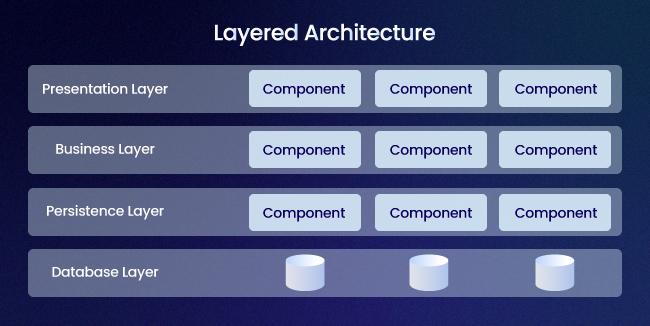
The purpose of each layer in the application is determined by its function, such as data storage, processing requests, or user interface presentation. Adjacent layers must be able to communicate information in a format that is acceptable for them. For example, the presentation tier should only show customer data and not manipulate it. At the same time, data may not flow from one layer to another unless it goes through all of the intervening layers.
In layered software architecture, the distribution of responsibilities and layer autonomy aid in simplifying application development, testing, management, and maintenance by defining clear component interfaces and restricting component scope.
The popularity of layered architecture stems from the fact that it's a simple default choice for a project. If you don't know where to start, starting with it might be beneficial. Because of the layers' isolation, any one of them may be readily modified or even entirely replaced if required.
As always, it's worth knowing the advantages and disadvantages of this type of architecture.
|
Pros: It's fairly easy to start. A large choice of frameworks is available. In general, if you don't know where to begin, layered architecture is an excellent place to start.
Cons: It might be challenging to add new features because, in general, you must build on several levels to provide them. It's challenging to scale up. It's tough to achieve top esults.
|
Event-Driven Architecture
The event-driven architecture is a fantastic alternative when developing highly scalable software solutions. It employs an asynchronous approach, which is excellent for producing highly scalable applications.Event-Driven Architecture
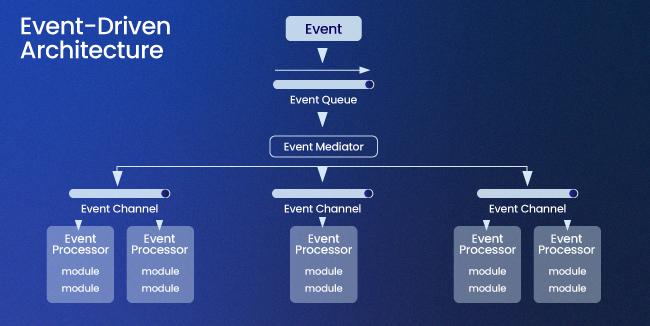
The event queue is the focus of this architecture. These events are subscribed to by several event processors, who work in parallel on the part of the overall job. When an event arrives in an online store, separate processors may be triggered to handle the warehouse reservation, invoicing, shipping, and other tasks. In this method, the beginning events may be divided into smaller channels that include processing events. Another method is to divide the event flow among processor components in a chain-like manner (suitable for simpler products).
The architecture may be combined in a variety of ways. For example, you might make one of the event processors layered or the other using event-driven architecture.
Like in the previous example, we couldn't go further without noting the benefits and drawbacks of this design.
|
Pros: It's easy to expand a processor's capabilities because most add-in processors operate independently. Testing is easy. It's not difficult to scale, and we may utilize different technologies in various processors. It's possible to achieve high performance.
Cons: Despite its apparent simplicity, the structure's design is challenging. It's tough to identify issues (due to the many interacting processes). It's tough to guarantee consistency down the road (due to asynchronous data modifications that might be delayed).
|
Plug-In Architecture
It is also called Microkernel architecture. It is often used for product-based applications. It allows you to add plugins to the core program, which provides extensibility and separation of various operations.
This architecture consists of a core system with only basic features and stand-alone plugin modules with additional capabilities. As a result, you may maintain only the essential connections and tailor the software to fit particular demands. It's also convenient to limit user access to various tasks.
Plugins may be connected in various ways, be completely autonomous, or need additional modules to operate. But it's critical to keep data transmission between components as restricted as feasible to minimize dependency concerns.
In web development, this style of architecture is unusual. A simple example of such an architecture is various IDEs. The fundamental edition is typically a text editor but may be improved using additional plugins.
Here are some advantages and disadvantages of this software architecture.
|
Pros: It's simple to add extra plugins to your project.
Cons: It isn't easy to design (because the basic system determines the format of future interactions.)
|
Microservice Architecture
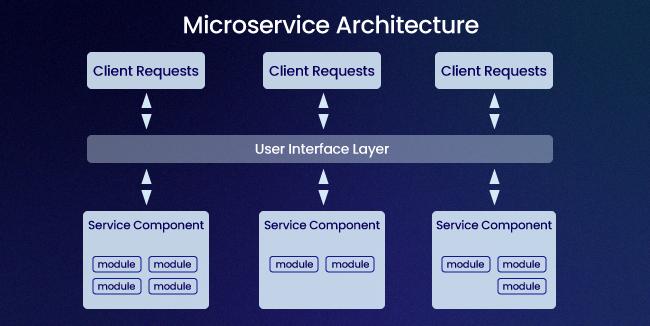
However, not everything is as black and white as it seems. In this architectural design, performance and scalability can vary depending on how the kernel is written and how the plugins interact.
Microservice architecture's popularity is because it was created to overcome well-known issues found in monolithic apps (high deployment costs) and service-oriented architectures (excessive complexity).
Each microservice component is deployed as a stand-alone unit and is entirely disconnected from the others. The details are reachable over the remote access protocol.
The increased scalability, simplicity of installation, and continuous release with a distributed architecture are all benefits. It is harder to achieve coordinated functioning because of the high degree of application and component decoupling in your application. Furthermore, it isn't easy to keep consistent processing of a single transaction by several service components. To preserve component independence, there's a good chance that many components' functions will be virtually identical.
Microservices, like event-driven architecture, hide complexity behind apparent simplicity. Here, you must correctly separate closely related services, consider the interface layer, guarantee data security and permissions, etc.
|
Pros: There's a lot of potential for customization. If the interface layer is created intelligently, it'll be simple to expand. Performance can be high thanks to component optimization. Scalability isn't very difficult.
Cons: It's easy to test one microservice, but testing the interactions of many microservices is also challenging to design.
|
Difficulties and Other Architecture Approaches
There's no need to claim that anyone's solution answers all your issues. So why would you want so many different answers? The aforementioned advantages and disadvantages may manifest themselves at various levels. Much hangs on the specifics of the implementation.
There's always a lot of complexity. However, the complexity in different architectures can look very different:
- Data conversion from one layer to the next is crucial in a Layered Architecture.
- It would help if you considered Eventual Consistency with Event-Driven Architecture.
- Microkernel Architecture enhances the kernel architecture's constraints.
- The interface layer between services is the most important in a Microservices Architecture.
Yes, we've seen several other methods of architecture software. However, many appear to be variations on well-known ideas with similar ideas on further examination. It's frequently more about emphasizing and delving deeper into some architectural framework. Before choosing an architecture, you must consider all of a certain project's duties.
However, a single extra checklist is never pointless.
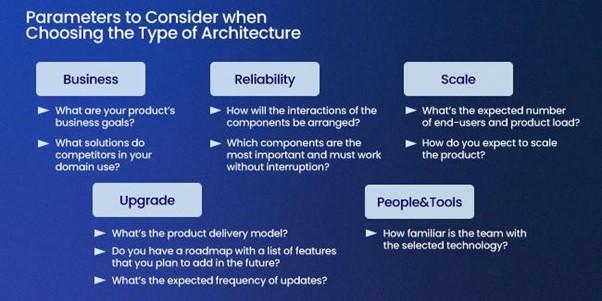
Try Not to Rush
You'll need to spend time/money and enlist qualified individuals again. It's critical to grasp that the Pre-Development decisions will be used as a basis for further product development. As a result, even seemingly minor interface tweaks, such as adding an icon or color scheme, might necessitate significant changes to the data structure.
Several things are considered when choosing an architecture for a project, including the developers' prior experience and background. Because the future project's scope is being determined at this time, an appropriate systematic technique should not be overlooked. It is important to pay attention to the vendor's suggestions and not overlook significant details.
Finding a firm specializing in creating sophisticated solutions for commercial requirements is a wonderful idea.
Conclusion
Good software architecture can help to guarantee the quality of a program as it is updated, maintained, and expanded. It also aids in the organization of software into microservices for ease of management. Nobody may ever get it perfect the first go-around.
Even the most accomplished software product development efforts have cruft. Still, an agile-driven team can find and deal with it sooner than later.
Finally, excellent architecture is beneficial in the long run since it is easier to scale and develop. It can save time for developers while still meeting the requirements of changing consumers.